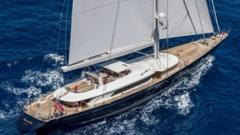The luxury superyacht Bayesian, owned by prominent UK tech entrepreneur Mike Lynch, met with a catastrophic fate on August 19 last year off the coast of Sicily, resulting in the deaths of seven individuals, including Lynch and his daughter. According to an interim report from the UK's Marine Accident Investigation Branch (MAIB), the yacht capsized due to "extreme wind" events, with gusts exceeding 80 mph inundating the vessel in mere seconds.
On the night of the incident, the vessel was sheltering from forecast thunderstorms, and had its sails furled. Initial wind conditions were moderate, with speeds of only eight knots (approximately 9 mph) at 3:00 AM. However, conditions deteriorated quickly; by 4:06 AM, wind speeds had reached 70 knots (80.6 mph), leading to the ship's catastrophic capsize. The report indicates that the yacht tilted to a dangerous 90-degree angle within 15 seconds, leaving little room for recovery.
While the MAIB is focused on UK laws since the vessel was registered in the UK, a simultaneous criminal investigation by Italian authorities has somewhat hampered access to vital evidence, delaying the inquiry. The MAIB's report is primarily based on limited verified evidence, and a final report's release is still pending with no set date.
Witness accounts indicate that the yacht's crew did attempt to respond to the rapidly worsening storm, engaging in critical actions such as closing hatches and preparing to start the engines. Dr. Simon Boxall, an oceanographer, emphasized that despite the crew's efforts, circumstances proved too severe for the boat to navigate. Survivors reported using furniture as improvised ladders to escape the rapidly flooding compartments of the yacht, and many managed to reach safety via lifeboats.
The tragedy also marks a notable moment in the life of Mike Lynch, whose illustrious career had been shadowed in recent years by legal disputes leading to his contentious extradition to the U.S. The inquest in the UK is currently addressing the circumstances surrounding the deaths, including those of several American nationals and the tragic loss of Lynch's daughter. The search for answers continues as the recovery operation to retrieve the sunken vessel remains underway, albeit paused after a diver’s death related to the ongoing efforts.
As the investigation unfolds, it frames a poignant narrative not only about the dangers of maritime excursions under adverse weather conditions but also about the life and legacy of a man who made significant contributions to the tech industry, raising pressing questions about safety regulations in high-stake maritime activities.






















